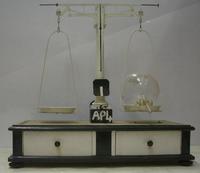Items
Site
The Medicine Chest
keywords is exactly
balance
-

Weighing Smoke
PAUL That’s the man. Well, Raleigh was the person who introduced tobacco in England, and since he was a favourite of the Queen’s – Queen Bess, he used to call her – smoking caught on as a fashion at court. I’m sure Old Bess must have shared a stogie or two with Sir Walter. Once, he made a bet with her that he could measure the weight of smoke. DENNIS You mean, weigh smoke? PAUL Exactly. Weigh smoke. TOMMY You can’t do that. It’s like weighing air. PAUL I admit it’s strange. Almost like weighing someone’s soul. But Sir Walter was a clever guy. First, he took an unsmoked cigar and put it on a balance and weighed it. Then he lit up and smoked the cigar, carefully tapping the ashes into the balance pan. When he was finished, he put the butt into the pan along with the ashes and weighed what was there. Then he subtracted that number from the original weight of the unsmoked cigar. The difference was the weight of the smoke. TOMMY Not bad. That’s the kind of guy we need to take over the Mets. PAUL Oh, he was smart, all right. But not so smart that he didn’t wind up having his head chopped off twenty years later. (Pause) But that’s another story. -

Weighing Air
An example from demonline (UCT Physics Department’s website with descriptions of educational demonstrations). Its descriptions reads: "A spherical flask of about 1 litre is suspended from one arm of a crude chemical balance. It is counterpoised by weights in the other pan, the tap attached to the sphere being open. This gives (roughly) the true weight of the glass. Unhook the sphere from the stirrup, attach the rubber tube from a rotary vacuum pump to the glass tube and evacuate for around 30s. Close tap, and re-attach stirrup. There will now be an upthrust on the flask equal to the weight of air removed, and the weights in the other pan will have to be reduced by about 1.2 g to restore the balance. Open the tap again: the air can be heard rushing into the flask (class must keep quiet), and the flask suddenly descends again". -

Devils Bridge sketched by Lister
'Devils Bridge' sketched by Lister on his travels through Europe showing a bridge crossing the Gotthard Pass, northern approach, Switzerland. The term 'devil's bridge' is applied to many ancient bridges found primarily in Europe. These were stone or masonry arch bridges and, because they represented a significant technological achievement in ancient architecture, were objects of fascination and stories. The most popular of these featured the Devil, either as the builder of the bridge (relating to the precariousness or impossibility of such a bridge to last or exist in the first place) or as a pact-maker (sharing the necessary knowledge to build the bridge, usually in exchange for the communities souls). The legend attached to the bridge sketched by Lister is of the latter, and was related by Johann Jakob Scheuchzer in 1716. According to Scheuchzer, the people of Uri recruited the Devil for the difficult task of building the bridge. In return for his expertise, the Devil requested the soul of the first thing to pass the bridge. To trick the Devil, the people of Uri sent across a dog by throwing a piece of bread, and the dog was promptly torn to pieces by the Devil. Reference: Scheuchzer, J. , 1747 [1716]. Naturgeschichte des Schweitzerlandes. Vol. 2: 94.


